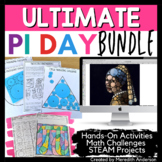STEM Activity Pi Day ➡️ Packaging Engineer Career Exploration Math Challenge ⭕
- PDF
- Google Apps™

What educators are saying
Also included in
- SAVE OVER 70% FOR A LIMITED TIME! 60 low prep STEM challenges PLUS everything you need to teach the Engineering Design Process! These activities are the perfect way to explore science concepts like sound, force and motion, aerodynamics, and more! Students will also find connections to STEM careers aPrice $37.00Original Price $153.50Save $116.50
- This activity set is only for DIE HARD Pi Day fans! Please view all of the resource previews to see what is included (it's a LOT). There's everything from math problems, hands-on pi exploration, STEAM art projects, logic puzzles, to STEM challenges with circles and more! Please note that Pi Day PopPrice $16.75Original Price $23.28Save $6.53
Description
A STEM activity with a career focus that is great for Pi Day or any time! In this hands-on math challenge, students will be packaging engineers for the day as they determine the best arrangement for a set of circles in the various packages! This 2D STEM challenge is a scaled-down, paper version of what real packaging engineers must accomplish with 3D objects and products. This activity ties in well to Pi Day because the objects are all circles! In a 3D version, these objects could be something like batteries, soup cans, straws, etc.
✂️ What You'll Get ✂️
- Teacher instructions and background information - vocabulary includes pi, area, tangent, radius, cross section, packing density
- Printable and digital STEM activity both elementary and secondary versions are included - elementary version has students calculate a point value for their arrangement, while the secondary version has students calculate packing density. All formulas are provided, including a reminder of how to find the area of the shapes included. Note: if you are working on mastering the use of a compass, you may opt to have students scribe their own circles.
- Guided recording sheets for students to record their results
- Background page on Packaging Engineering and discussion questions
- Printable circles - these are the "products" students need to package
- Printable "packages" - students need to determine the best package for the products
What Teachers Are Saying
⭐⭐⭐⭐⭐ "This is a really unique resource. The kids were very engaged and had fun completing it. Thank you!"
⭐⭐⭐⭐⭐ "My students loved this. It became quite the fun competition and I think that helped them grasp the concept better."
⭐⭐⭐⭐⭐ "Great quick STEM resource. Easy to use and to follow."
⭐⭐⭐⭐⭐ "My 4th graders were very engaged and were able to have great discussions with their classmates in this activity."
Why You Should Try This STEM Activity
There are a number STEM careers out there for students, and this is one way to explore what an engineer might need to do on the job. I have scaled this challenge down to use only paper so that it is accessible for any student (or digital if for some reason paper is not an option!).
This activity will encourage students to think outside the box, come up with predictions, and reason why they think a particular solution might be better than another.
This is also a terrific hands-on math activity and students may be surprised when they find that the "packages" all have the same area!







